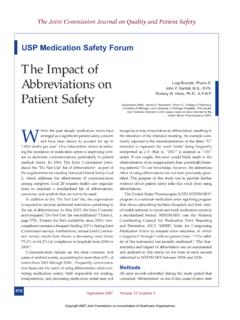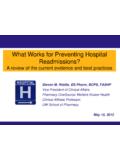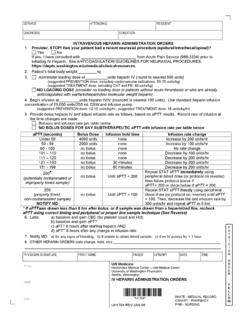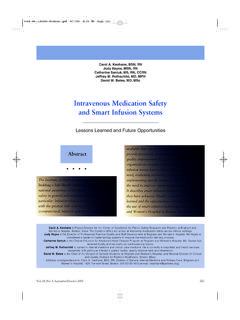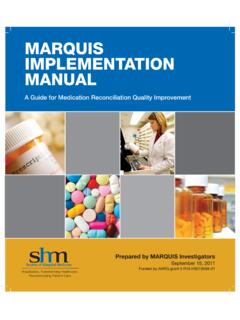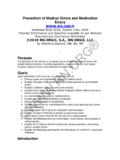Transcription of National Patient Safety Goal 8—Medication …
1 National Patient Safety Goal 8 medication reconciliation During October 2009, The Joint Commission hosted focus group calls with its ambulatory health care, behavioral health care, critical access hospitals, hospital, home care, long term care, and office-based surgery customers on the medication reconciliation National Patient Safety Goal. The groups discussed the components of a medication reconciliation process; the points in the care process that need to be addressed; and the ideal elements for the medication reconciliation goal. The outline below categorizes participant feedback into distinct themes. Defining medication reconciliation and the list medication reconciliation must occur at initial contact for each time care is provided (for the Patient s unrelated ailments).
2 (Hospital) Organizations need a clear definition for active medications. (Hospital) Organizations need a defined timeline after admission to have the list created (Hospital) medication reconciliation has largest impact immediately after discharge (Hospital) Standards should be based on type of visit (encounter and setting) rather than physical location (primary care clinic, ambulatory surgery center, urgent care) (Ambulatory/Diagnostic, Hospital) At a minimum, obtain a complete list of medications (OTC, vitamins, and supplements) from Patient and include history of adverse reactions and allergies to include food allergies. (Ambulatory/Surgery) reconciliation should be done when multiple medications from same class are prescribed and when starting and stopping medications that tie into avoiding surgical complications (Ambulatory/Surgery) There needs to be a clear definition of what a medication reconciliation list is.
3 Some think it is the physical list, but the comparison is the critical Safety component. (Hospital, Home Care) Describe the intent of the term reconciliation , but do not be too prescriptive with specific requirements (Hospital, Behavioral Health Care) There are struggles with clearly defining who has ownership of the medication reconciliation process/ final medication list. (Home Care) Patient Education The public/ Patient needs to be educated about the importance of the list (Hospital, Ambulatory/Surgery, Home Care) Multidisciplinary approach Address the importance of approach being multi-disciplined Registered Nurse, Pharmacy, Administration, and Physician. (Hospital) medication reconciliation works best when the pharmacy is involved in the process: the goal should address dialogue with pharmacy.
4 (Hospital, Behavioral Health Care) Flexibility The goal should focus on the ideal outcome, , ensuring that information about a Patient s current medications is accurate and complete across the continuum of care. Allow organizations to develop their own policies and procedures that utilize the pharmacy, physician, and nurse to produce the outcome. However, Joint Commission should still have some minimum requirements about what should be contained in the policy. (Behavioral Health Care, Hospital, Ambulatory/Surgery, Long Term Care) Flexibility is needed to accommodate organizations with paper and electronic medical records. (Ambulatory/Diagnostic) There will never be a single best practice because of the many different settings.
5 (Hospital) The biggest struggle is getting information from outside entities. Adding flexibility to the goal/allowing organizations to document their attempts and proceed without the information would be appreciated. (Behavioral Health Care) The requirements should be more specific and provide more clear direction; focus on processes rather than just outcomes. (Home Care) The prescriptiveness of the current requirement has been a stumbling block. (Hospital) The goals should allow organizations to take advantage of other work processes to avoid redundant efforts; currently the medication history is gathered several times. (Hospital) Describe the intent of the term reconciliation , but do not be too prescriptive with specific requirements.
6 (Hospital) Transfers between levels of care The reconciliation process should address when levels of care change, even within ICUs. For long term care, changes in levels of care include when patients move from assisted living or when they visit clinics, etc. For behavioral health care, changes in levels of care include when patients leave the organization overnight or go to an acute care facility for an emergency, etc. (Behavioral Health Care, Hospital, Long Term Care, Home Care) Clarification needed regarding transfers, referrals, leaving organization. (Ambulatory/Diagnostic) There is value in having all medications listed in a central part of medical record. Each provider s sign off indicates they have reviewed and reconciled the list.
7 (Ambulatory/Surgery) The goal should address arrival, internal passes, and leaving the organization. (Behavioral Health Care) Challenges There is a struggle with clarifying level(s) of responsibility in reference to communicating the list to next provider. (Hospital) Challenge getting correct list on admission from patients . (Hospital) Surgeons are not comfortable changing Patient s meds. It is more realistic to focus on meds taken for the episode of care. (Ambulatory/Diagnostic) Who is responsible if Patient gives incorrect name of medications he or she is taking? The next provider will not have an accurate list. (Ambulatory/Diagnostic) Primary care offices do not want the medication list.
8 It only becomes part of their medication reconciliation process when the Patient comes back for care. (Ambulatory/Surgery) Sending the list to the next provider of care has been a problem burdensome and time consuming. It would be ideal if there was more responsibility on the Patient to bring the list to the next provider. (Hospital) The exchange of information between discharging and admitting providers can be a problem. (Long Term Care) Specific Behavioral Health Care issues include foster care children (hard to obtain information from case managers), access to legal custodians in residential settings, patients who leave against medical advice, and acquiring permission to release information at discharge.
9 (Behavioral Health Care) Documentation is cumbersome. (Behavioral Health Care, Hospital) It s easiest to do medication reconciliation when a Patient is from the same health system. Non-accredited retail pharmacies pose the most problems. (Home Care) Where do you draw the line? If the Patient s list is lacking, how much time do you spend trying to make it accurate? Getting a complete list is a problem. (Hospital) Difficult to identify current medications for new residents; information from hospitals is often incorrect. (Long Term Care) Minimum Use Settings Focus the NPSG on certain classes of drugs (Ambulatory/Diagnostic) There is no value for radiology techs to have list of meds unless it is for a radiologic procedure.
10 Don t have staff with skill to do a medication reconciliation (Ambulatory/Diagnostic) Delineate between physician responsible and physician acknowledgement of the medications on the list. ASC should be knowledgeable (not responsible) of all medications the Patient is taking. (Ambulatory/Surgery) Need to know classes, doses, and frequency that may not apply in other settings and organizations. (Ambulatory/Diagnostic) For the effort, medication reconciliation has provided little benefit in shelter programs where they are not generally prescribing medications (only for a few clients). (Behavioral Health Care) medication reconciliation has little value for radiology, and it is duplicative in physician s offices.
